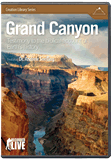
Climbing the “Ladder of Life” in the Grand Canyon
Editor’s Note: First published in St. Louis MetroVoice 4, no. 7 (July 1994).
Several years ago, I was challenged by an evolutionist colleague to visit the Grand Canyon in Arizona. He assured me that a hike into the Grand Canyon would be a “sure-cure for creationism.” Here, he said, I would see that the many layers of rock forming the walls of the Canyon get progressively older as one descends from the rim (where the rocks are claimed to be 270-million years old) to the bottom (where the rocks are said to be well over a billion years old). Then, he claimed, as I ascended the wall of the Canyon I would be climbing up the evolutionary “ladder of life”! He assured me that the fossils in each succeeding layer of rock would reveal the progressive steps of over a billion years of evolutionary history, ranging from the first living cells to the early reptiles. Surely, if one is to see physical evidence of the progressive stages of evolution anywhere on earth, the Grand Canyon should be the place to look. Well, after researching the Grand Canyon, I accepted the challenge to pay it a visit. In fact, I visited the Canyon on three different occasions and twice hiked its trails from river to rim. I discovered that not only are the evolutionist’s “missing links” truly missing—their whole “ladder of life” is missing!
I discovered that not only are the evolutionist’s “missing links” truly missing—their whole “ladder of life” is missing!
The Grand Canyon is about 277 miles long and, in places, over a mile deep. Its walls reveal 21 distinct layers of mostly sedimentary rock. The deepest, and presumably oldest, layers of sedimentary rock in the Grand Canyon are collectively known as Precambrian strata. For over 100 years, geologists have searched for fossils in Precambrian layers all over the earth in hope that they might see how the first living organisms evolved. In the Canyon, as elsewhere, Precambrian fossils are largely limited to curious dome-shaped, laminated structures called “stromatolites.”1 While there is some question whether these stromatolites are really a product of living organisms, similar structures are formed in our oceans today by mats of one-celled photosynthetic organisms called “cyanobacteria.”
The next three layers of the Canyon (Tapeats Sandstone, Bright Angel Shale and Muav Limestone) are collectively identified as Cambrian strata and are said to range from 530 million to 500 million years old. Here, many fossils of trilobites, oysters, clams, corals, worms, and brachiopods are suddenly found. All of these are marine invertebrates, and all (with the possible exception of trilobites) have representatives living in our oceans today. Paleontologists speak of the great “Cambrian explosion” because, all over the world, these layers show the sudden appearance of fossils representing virtually every phylum of animals. In not a single case is there fossil evidence to show what their presumed ancestors looked like—they appear all at once and fully formed!
The next two fossil-bearing layers encountered in our climb up the Canyon’s “ladder of life” are the Redwall Limestone (said to be 340 million years old) and the Supai group (285–315 million years old). These layers contain fossils of more marine invertebrates, including three relatively simple types not seen in the lower layers—the bryozoans, crinoids, and foraminiferans. All three have living representatives in our oceans today. The foraminiferans are of particular interest because they are a phylum of one-celled marine organisms that evolutionists consider to be among the first forms of life to have evolved a nucleus. Why then are these “primitive” single-cell organisms first encountered halfway up our “ladder of life”? So far, our “ladder” seems to be pretty much a “one rung” affair, with no obvious vector of evolutionary progress. It gets worse, however. The next rung shows evidence of footprints—but no feet!
One of the most amazing facts about the Grand Canyon is that no one has ever found a fossilized bone embedded within the layers which make up the walls of the Canyon! Beginning in the Supai layer and extending upward into the Hermit and Coconino layers, countless fossilized footprints of over 20 species of amphibians and reptiles suddenly appear—but no fossils of their bones or teeth! The bones of tetrapods (four-legged animals) that could have made these footprints have only been found in strata located several miles away from the Canyon to the northeast. Interestingly, the occurrence of footprints in strata well below the layers in which fossilized bones are first found is not unique to the Grand Canyon. Geologists concede that this is a worldwide phenomenon! How then can we consider the fossils in the geologic column to be a reliable record of evolutionary succession? Are we to believe that footprints evolved millions of years before feet? Those who accept the Biblical account of Noah’s flood might prefer to think that the common occurrence of footprints in strata below those bearing the bodies themselves reveals something about how long these tetrapods could tread water before drowning!
Even more amazing is the fact that most of the fossil footprints in the Coconino are headed in the same direction!
Even more amazing is the fact that most of the fossil footprints in the Coconino are headed in the same direction! Are we to believe that for 10 million years amphibians and reptiles mostly walked in the same direction? Not only are the majority of these footprints headed in a northerly direction, but this direction generally slopes uphill! While camping in the Canyon, I heard a park ranger give a lecture on its fossils. She was quite serious when she explained that geologists now believe the reason most fossil footprints head uphill is that the reptiles who made them always walked uphill (leaving footprints), but had a habit of sliding down hill! Certainly, one could make a more plausible argument for reptiles running up hill to escape the advancing waters of Noah’s Flood, than one could for “lazy lizards.”
The top two layers of the Canyon are the Toroweap and Kaibab layers. Neither layer shows evidence of footprints of any kind and, of course, there is still no trace of bones. Fish teeth have been found in the Kaibab, but this is clearly a case of too little, too late. To add insult to injury, the Kaibab Limestone layer at the very top of our “ladder of life” shows the only evidence to be found in the Canyon of fossilized sponges! This is embarrassing to evolutionists, because sponges are a loose collection of living cells that are believed to be the first multicellular organisms to have evolved on earth.
It’s easy to come away from the Grand Canyon thinking you have made a startling discovery that evolutionists ought to know about—there is no evidence of evolutionary progress in the fossils of the geologic column! I was surprised to learn that evolutionists are already aware of this fact, although you would never guess it from the evolutionary indoctrination presented in public schools and popular media. Harvard evolutionist Stephen Jay Gould appears to have no illusions about the evidence for evolutionary succession in the geologic column when he says,
I regard the failure to find a clear vector of progress in life’s history as the most puzzling fact of the fossil record. (Natural History 93:23).
A hike to the bottom of the Grand Canyon is a sure cure for evolutionism, but don’t expect to climb out on the “ladder of life”—it isn’t there!
Essays on Origins: Creation vs. Evolution
Footnotes
- The Cambrian Burgess shale deposits in the Canadian Rockies contain an extraordinary diversity of bizarre invertebrate fossils that bear only the slightest resemblance to animals and plants that suddenly appear in the post- Cambrian fossil record.
Recommended Resources

Answers in Genesis is an apologetics ministry, dedicated to helping Christians defend their faith and proclaim the good news of Jesus Christ.
- Customer Service 800.778.3390
- Available Monday–Friday | 9 AM–5 PM ET
- © 2025 Answers in Genesis



